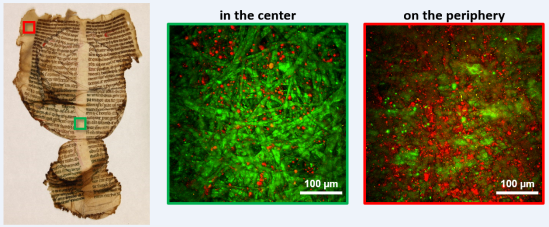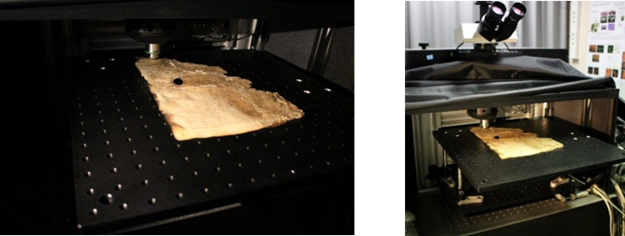A new non-invasive technique for parchment diagnosis
The conservation state of parchments is typically assessed using invasive and sometimes destructive investigation techniques. Scientists from Université Paris-Saclay, the CNRS, École Polytechnique, and the French Ministry of Culture[1] have developed a non-destructive and non-invasive advanced optical imaging technique to quantitatively assess the degradation state of parchments.
The approach was validated using artificially-aged samples and then applied to 13th century parchment manuscripts from the renowned collection at the Chartres Library. Their work was published in the journal Science Advances on July 16, 2021.
In the Middle Ages, parchment was the main writing support prior to the arrival of paper. Parchment is made from animal skin which is treated, scraped and dried under tension. After the manufacturing process, the main remaining constituent is collagen, a fibrillar protein.
Parchments are incredibly sensitive to heat and water and the combination of the two can lead to an alteration in the multiscale structure of fibrillar collagen. The ultimate stage of collagen degradation is a total loss of fibrillar organization, i.e. the formation of gelatin, which can cause the parchment to become transparent and rigid.
The main challenge for conservation scientists and conservators today is to identify the conservation state of parchment in order to select the optimal restoration treatment and the conservation conditions. Currently, the assessment of parchment degradation usually involves sampling with destructive investigation techniques.
Nonlinear optical (NLO) microscopy is a 3D imaging technique that provides micrometer-scale resolution images. By combining second harmonic generation (SHG) signals, which are sensitive to fibrillar collagen, with an analysis of the polarization of the state of light, it is possible to measure the degree of alignment in the fibrillar collagen, which is closely related to the state of degradation.
This approach was tested on a set of contemporary parchments, which were artificially altered by heat exposure for increasing durations and then validated by comparing them with a reference technique to assess the conservation state.
Nonlinear optical microscopy was then used to analyze historic 13th century parchment manuscripts belonging to the renowned collection at the Chartres Library. Some of these manuscripts were destroyed or damaged to varying degrees when the city was heavily bombed in 1944 during the Liberation.
The parchments were exposed to fire (and subsequently heat) as well as water, which was used by the firefighters to put out the fire. In 2009, some of the damaged documents were restored using humidification in order to flatten the parchments. Using nonlinear optical microscopy, the researchers were able to map the conservation state of several parchment manuscripts and confirm the absence of impact from the restoration process.
These results create new possibilities for the analysis of collagen-based cultural heritage artefacts, such as parchments, leather, or natural history specimens dried or preserved in fluids. More generally, this nonlinear optical microscopy technique, which still remains relatively unknown in heritage sciences, offers new possibilities for uses in a wide range of fields.
Read the full publication in Science Advances: https://advances.sciencemag.org/content/7/29/eabg1090.abstract

Figure 1: Picture of a parchment manuscript from the collection at the Chartres Library (Copyright: CNRS-IRHT). False colour images of nonlinear optical microscopy with second harmonic generation signals for the fibrillar collagen (in green) and two-photon excited fluorescence linked to collagen degradation (in red). The centre of the parchment is well-conserved, while the edges are more altered due to their higher exposition to environmental conditions.

Figure 2: Pictures of the nonlinear optical microscope from the Laboratory for Optics and Biosciences (LOB - CNRS, École Polytechnique - Institut Polytechnique de Paris, Inserm) analyzing a historic parchment from the Chartres Library. (Copyright: M. Schmeltz, LOB).
